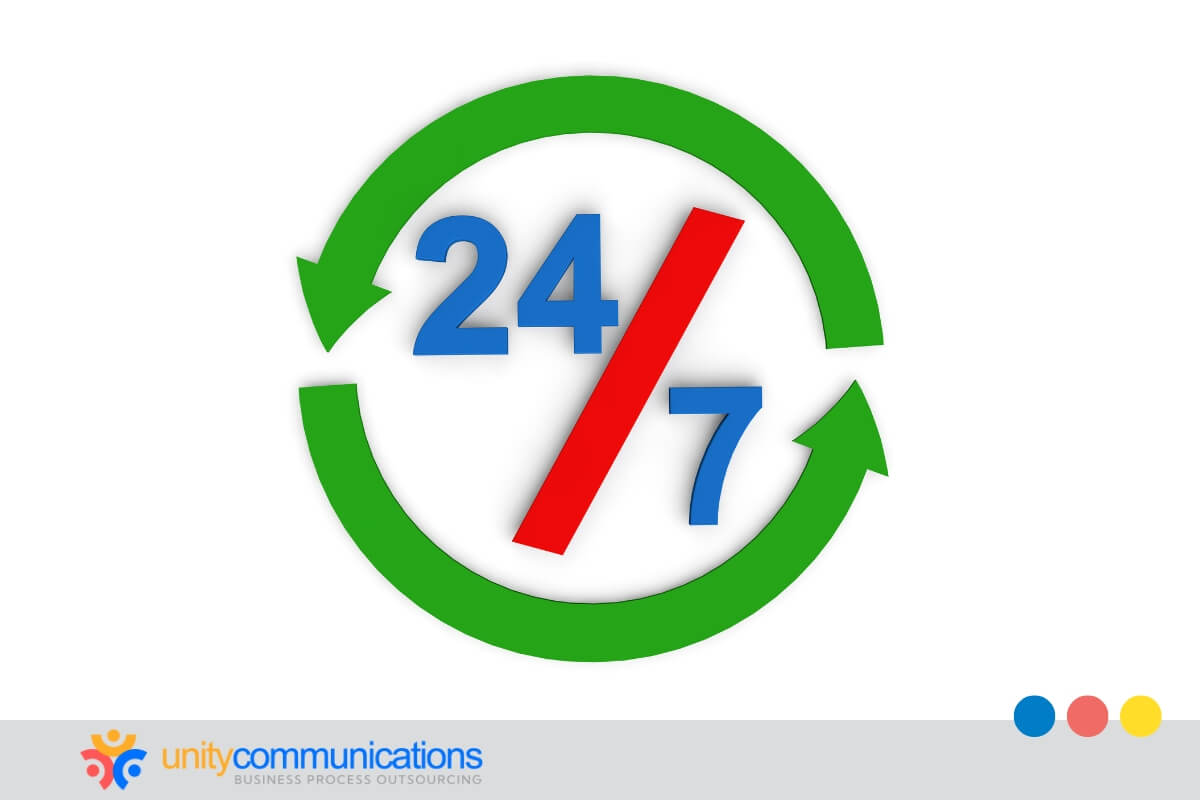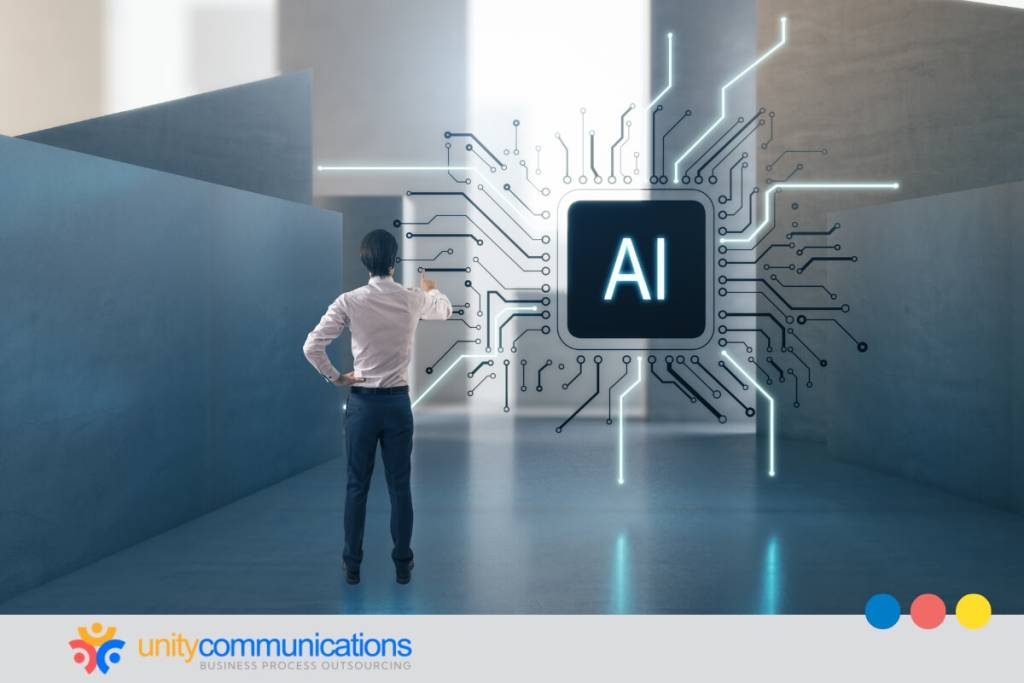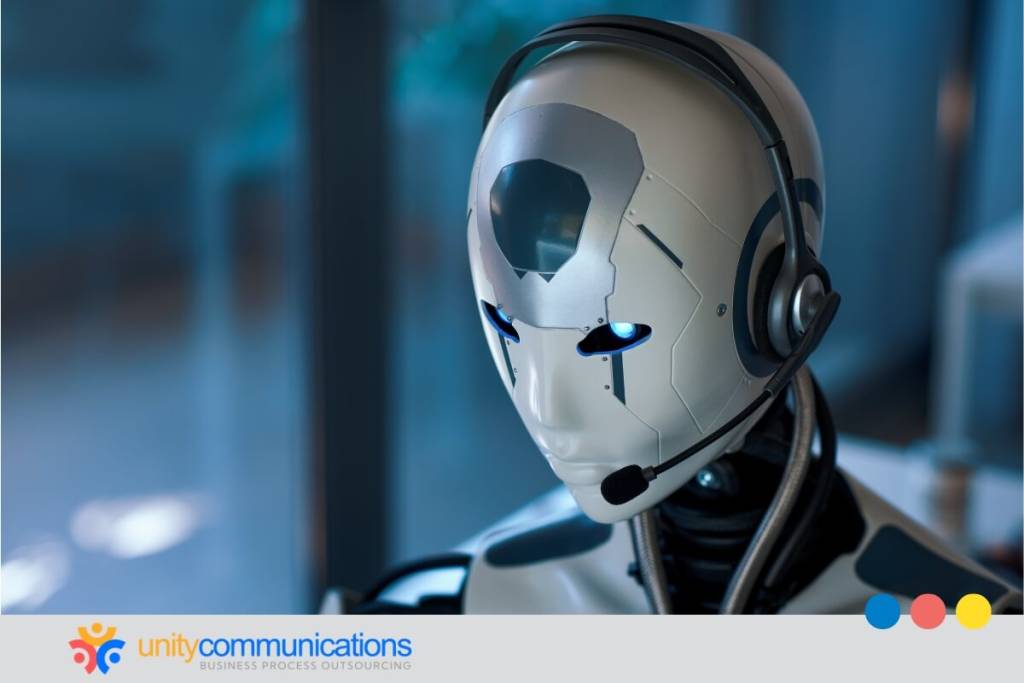Businesses today face constant pressure to do more with less, and many are turning to AI-powered systems to meet this challenge. Among the most effective solutions are AI agents—intelligent tools that can automate processes, make decisions, and support teams in real time.
To understand what an AI agent is and how it creates value, you must look at the underlying design. This is where AI agent architecture comes in, outlining the layers and workflows that enable these systems to operate quickly, accurately, and adaptively in business environments.
AI agents in outsourcing

To truly understand their value, it’s essential to examine AI agent architecture, which defines the layers and workflows that enable agents to sense, reason, and act.
Valued at $279 billion in 2024, the global AI market is projected to reach $3.5 trillion by 2033. This impressive expansion signals the significant role of intelligent systems in businesses. In particular, AI agents are transforming how modern enterprises rethink how outsourcing works in today’s digital-first economy.
Traditionally, business process outsourcing (BPO) meant delegating repetitive or specialized tasks to external teams to cut costs and refocus internal talent. AI agents take this model further by executing processes directly, operating 24/7 with consistency, adaptability, and precision.
Rather than replacing outsourcing, this evolution enhances it, combining human expertise and intelligent automation to deliver greater efficiency and scalability.
The following characteristics of AI agents make it a natural fit for outsourcing:
- Scalability on demand. AI agents can instantly handle spikes in workload without delays in hiring or training new staff.
- 24/7 availability. They do not need breaks or shifts, ensuring nonstop support for global operations.
- Consistency and accuracy. Unlike humans, who might tire or make errors, AI agents deliver uniform results across repetitive tasks.
- Cost efficiency. By automating high-volume processes, they reduce labor expenses while maintaining performance.
- Adaptability. AI agents can learn from data, improving their responses and adjusting to new workflows.
- Integration with existing systems. They connect seamlessly with enterprise tools, application programming interfaces (APIs), and platforms, extending the reach of outsourcing.
These traits make AI agents a powerful complement to traditional outsourcing models, helping businesses scale faster and smarter.
Core layers of AI agent architecture
An AI agent architecture is a structured framework that determines how an agent perceives, processes, and acts on information. These layers ensure that agents receive data, interpret it, and deliver meaningful outcomes.
By breaking this system into input, reasoning, and output, you can better understand how AI agents function in real-world business settings. Each layer plays a distinct role, contributing to the intelligence that powers modern organizations.
1. Input layer
In some evaluations, AI systems have even surpassed human performance in language understanding and image recognition.
This capability begins at the input layer, where an AI agent collects data from its environment, users, or connected systems:
- Collects structured and unstructured data (text, images, voice, logs)
- Interfaces with sensors, APIs, or databases
- Pre-processes and filters data for accuracy
This part of the AI agent architecture forms the essential foundation for reasoning and decision-making that follows.
2. Reasoning layer
The reasoning layer is the “brain” of the AI agent architecture, analyzing information and transforming it into actionable insights. It:
- Uses algorithms, machine learning (ML), or large-language models (LLMs) to interpret input
- Evaluates different options before selecting a course of action
- Incorporates memory and context for smarter results
It is in this layer that logic, rules, or models drive decision-making.
3. Output layer
The output layer translates decisions into visible results or actions. It connects the agent’s intelligence to the real world, delivering value. It:
- Executes actions (sending alerts, triggering workflows, updating systems)
- Communicates insights or recommendations to users
- Provides feedback that can loop back into future inputs
Together, these three layers ensure that AI agents operate as complete systems capable of sensing, thinking, and acting to effectively support business goals.
Reactive, deliberative, and hybrid approaches
AI agents do not think and act the same way. The operation of the AI agent architecture depends on the approach guiding its decisions. Some agents respond instantly to changes, while others pause to analyze before acting, and many combine both strategies.
Reactive, deliberative, and hybrid methods shape agents’ performance in different business scenarios. Understanding these models helps you choose the right type of agent for your goals and workflows.
Reactive agents
Reactive agents focus on quick responses, acting immediately based on inputs without deep analysis or long-term planning.
Examples:
- Chatbots answering frequently asked questions (FAQs) in real time
- Security systems detect and block suspicious logins instantly
- Customer service routing based on keywords in messages
These agents are simple but effective for handling repetitive and predictable tasks at scale.
Deliberative agents
Deliberative agents take time to plan and reason before making decisions, often using models or simulations to predict outcomes.
Examples:
- AI scheduling systems allocate resources based on constraints.
- Virtual assistants compare travel routes and costs before booking.
- Financial tools evaluate risk before approving credit applications.
These agents are ideal for complex problems where accuracy is more important than speed.
Hybrid agents
Hybrid agents combine the speed of reactive systems with the foresight of deliberative ones. They balance instant responses with deeper analysis, making them versatile for dynamic business environments.
Examples:
- E-commerce recommendation engines provide quick suggestions while refining results over time.
- Logistics AI that reroutes deliveries in real time while optimizing long-term supply chain plans.
- Fraud detection tools that block obvious threats instantly while investigating borderline cases further.
These decision-making models are built on the foundation of flexible AI agent architectures that balance speed and accuracy.
By blending these approaches, you can deploy agile and strategic AI agents that balance between speed and intelligence.
Modular architecture: Sensing, planning, and action execution
Modern AI agent framework leverages modular design principles, decomposing complex operations into specialized, interconnected components.
This approach enables you to customize agent capabilities while maintaining system flexibility and scalability, which are essential as you increasingly adopt intelligent automation solutions.
Nearly 92% of companies plan to increase their investments in generative AI within the next three years, signaling a strong push toward more advanced and adaptable solutions.
By structuring functions such as sensing, planning, and acting, you can fine-tune performance without disrupting the system. The result is smarter, more reliable AI agents that deliver consistent value in real-world applications.
Sensing
Although generative AI is still emerging, 51% of marketers are already experimenting with it or planning its adoption, demonstrating how quickly businesses are embracing intelligent tools.
At the core of these tools is sensing, which is how an AI agent collects data from customer interactions, system activity, or market signals.
Examples:
- Customer feedback analysis through chat or surveys
- Monitoring website traffic and user behavior
- Detecting anomalies in financial transactions
Accurate, timely input is essential because, without strong sensing, even the most advanced reasoning cannot deliver reliable outcomes.
Planning
Planning allows agents to transform raw data into strategies and next steps. This module maps out possible actions, prioritizes them, and selects the path most likely to succeed.
Examples:
- Allocating resources in project management tools
- Forecasting demand in retail supply chains
- Scheduling staff based on predicted service needs
Planning aligns AI solutions with goals and constraints.
Acting
Acting is where decisions turn into outcomes or when the agent carries out its chosen plan. This module executes tasks directly, often interacting with other systems, tools, or people. Strong acting capabilities make AI agents reliable partners in day-to-day operations.
Examples:
- Sending automated responses to customer questions
- Processing transactions or updating databases
- Adjusting delivery routes for efficiency
Sensing, planning, and acting together form a robust, modular AI agent architecture tailored for efficiency and impact.
Integrating LLMs into the framework

LLMs transform how AI agents operate by serving as the reasoning and communication engine within workflows.
Instead of relying solely on rigid, rule-based systems, agents powered by LLMs can interpret context, generate natural language, and adapt to complex situations. They can provide more human-like interactions, handle diverse tasks, and scale across multiple domains.
LLMs bridge the gap between raw data and actionable intelligence. Consider the following:
- Embedding LLMs into customer support agents to handle inquiries with natural, human-like responses
- Using LLMs to summarize large volumes of business data for decision-making
- Enabling dynamic task planning, where LLMs propose and refine action steps
- Automating documentation, report drafting, and communication flows
- Powering virtual assistants that manage schedules, reminders, and knowledge retrieval
When seamlessly integrated into the AI agent architecture, LLMs elevate agents from simple task executors to adaptable, context-aware business partners.
Memory and state management for contextual intelligence
For AI agents to act intelligently, they need more than immediate inputs. They require memory and awareness of prior interactions. Memory and state management enable agents to track context, recall important details, and adjust their responses accordingly based on their history.
This fosters continuity and relevance over time, resulting in personalized and effective outcomes.
Here are ways AI agents apply contextual intelligence:
- Retaining customer preferences across multiple service interactions
- Tracking the progress of long-term projects or workflows
- Remembering past errors to prevent repeating mistakes
- Maintaining session history for seamless multi-step conversations
- Using state awareness to coordinate tasks across multiple systems
With strong memory and state management, AI agents become more reliable partners, capable of learning and adapting to real-world business needs.
Decision-making and planning as core control
At the heart of every AI agent lies its ability to make decisions and plan effectively. This control core ensures that agents proactively chart the best course of action to achieve defined goals.
Agents deliver more strategic and reliable performance by weighing options, anticipating outcomes, and adapting to changing conditions.
Here are ways AI agents apply decision-making and planning skills:
- Prioritizing tasks in project management systems to meet deadlines
- Optimizing delivery routes in logistics for cost and time efficiency
- Adjusting marketing campaigns based on real-time engagement data
- Allocating IT resources dynamically to prevent downtime
- Reallocating staff schedules in response to demand spikes
When decision-making and planning drive the process, AI agents shift from being mere task handlers to strategic partners.
Tool use and action execution pathways
AI agents rely on tools and action pathways to transform decisions into real-world outcomes or augment their capabilities beyond mere reasoning. These range from APIs and databases to scheduling systems and analytics platforms.
With the right tools, agents can execute tasks quickly, accurately, and at scale. This connection between decision-making and action makes AI truly impactful in business operations.
AI agents utilize tools to boost efficiency. Here are some examples:
- Accessing customer relationship management (CRM) systems to update customer records automatically
- Using scheduling software to book meetings or assign resources
- Querying databases to fetch and analyze critical business data
- Sending automated responses through communication platforms
- Triggering workflows in project management tools to keep processes moving
With strong tool integration, AI agents act, driving measurable outcomes that directly support organizational goals.
Multi-agent collaboration and hierarchical control
In complex AI agent architecture environments, multi-collaboration allows several agents to work together. Each specializes in a different task, while hierarchical control ensures they remain organized under a structured chain of command.
This setup mirrors how you delegate responsibilities across teams and managers, creating efficiency and accountability. The result is a system that can precisely handle large-scale, dynamic operations.
Here are examples of multi-agent collaboration with hierarchical control in various business settings:
- Customer service agents manage different support channels while escalating complex issues to a supervisory AI.
- Supply chain agents coordinate inventory tracking, shipping schedules, and vendor communications.
- Financial monitoring agents detect anomalies while compliance agents validate regulatory requirements.
- Workflow orchestration means smaller task agents report to a central decision-making controller.
- Marketing agents divide roles between content creation, analytics, and campaign optimization.
By combining collaboration with hierarchy, you gain AI systems that are specialized and scalable, and capable of running well-coordinated teams.
Execution cycles: Event-driven vs. loop-based models

Every AI agent follows an execution cycle, which defines how it processes information and responds to tasks. Two standard models are event-driven and loop-based, each with its own strengths, depending on the business use case.
Event-driven models
Event-driven models operate by responding to specific triggers or signals from the environment. They are efficient because they activate only when an event occurs, making them ideal for systems that require immediate action.
They have excellent response times and waste less computational effort compared to constant monitoring.
You can use this model in scenarios where timing is critical. Here are some examples:
- Fraud detection agents flag unusual transactions as soon as they happen.
- Customer support bots respond instantly to incoming inquiries.
- Smart monitoring systems alert operations teams to outages or anomalies.
- Marketing triggers send personalized offers when customers take an action.
Event-driven models excel in dynamic environments where speed and precision have a direct impact on business.
Loop-based models
Loop-based models operate in continuous cycles, continually checking for changes in data, the environment, or instructions. Unlike event-driven approaches, they do not wait for a signal as they actively monitor and update.
This model is useful when ongoing oversight and updates are necessary, even if no clear “event” has occurred. While more resource-intensive, it ensures nothing slips through the cracks.
Here are examples of this model:
- Supply chain agents continuously track shipments and inventory levels.
- Risk management systems monitor financial markets for gradual shifts.
- Predictive maintenance agents regularly inspect machinery health.
- Data collection bots gather insights across multiple sources nonstop.
Loop-based models offer reliability and persistence, making them valuable in situations where continuous oversight is crucial. By combining event-driven speed with loop-based persistence, you can design AI agents that balance responsiveness and consistency.
Scalability, monitoring, and system resilience
Building resilient AI agent architectures ensures systems can scale reliably and recover from disruptions. PwC’s 2025 Global AI Jobs Barometer reports that sectors leveraging AI experience a threefold increase in revenue growth per employee compared to less AI-exposed industries.
This momentum underscores why businesses adopting AI agents must ensure their underlying systems are built for scale, governance, and resilience. Scalability enables agents to handle expanding workloads without compromising performance, while monitoring safeguards visibility and efficiency across operations.
At the same time, system resilience allows agents to withstand failures, adapt quickly, and recover from disruptions. These three pillars form the foundation for deploying AI agents at enterprise scale.
Scalability
Scalability refers to an AI agent system’s ability to grow seamlessly as demand increases. Whether more users, larger datasets, or complex workflows, scalable AI agent architectures adjust without slowing down or breaking.
With scalability, you can expand without constantly rebuilding your systems. A scalable AI agent grows in tandem with the business, rather than becoming a bottleneck. Consider these examples:
- Customer service agents handling surges in inquiries during peak seasons
- Workflow automation scaling with new departments or business units
- Data analysis agents adapting to expanding datasets
- E-commerce recommendation engines serving millions of customers at once
Scalability gives businesses long-term flexibility and growth potential.
Monitoring
Monitoring keeps AI agents accountable by tracking real-time performance, accuracy, and reliability. It can quickly detect errors, inefficiencies, or biases before they cause damage.
Proper monitoring also helps you optimize performance and comply with regulations. With continuous oversight, your agents stay aligned with business goals.
- Dashboards tracking the response times of customer support agents
- Alerts when automated decisions fall outside expected accuracy rates
- Bias detection tools monitoring hiring or lending recommendations
- Resource usage monitoring to keep systems efficient
Monitoring provides visibility and control, making AI agent operations transparent and trustworthy.
System resilience
System resilience ensures AI agents withstand disruptions and function reliably under stress. This includes designing for fault tolerance, backup systems, and recovery strategies.
Resilient agents protect your business from downtime, data loss, or critical failures. The stronger the resilience, the greater the confidence you can have in your AI systems.
Here are some examples:
- Backup workflows take over in the event of a system crash.
- Failover mechanisms reroute tasks when servers go down.
- Cybersecurity agents safeguard systems against malicious attacks.
- Recovery protocols restore lost data quickly.
System resilience builds trust and reliability, ensuring AI remains a dependable business partner.
By focusing on scalability, monitoring, and resilience, you can create AI agents that perform well and remain robust, reliable, and ready for the future.
The bottom line
AI agent architecture is the foundation that allows intelligent systems to sense, reason, and act in ways that support real business needs.
By understanding its layers, workflows, and decision-making models, you can harness AI for growth and efficiency.
When combined with strong governance and resilience strategies, these agents become reliable partners in daily operations.
Organizations that master this balance will lead their industries in efficiency, innovation, and competitive advantage. Let’s connect if you want to learn more.




